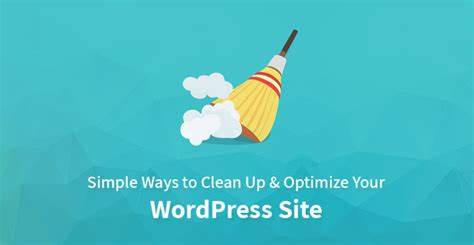Clean up WordPress website is essential for maintaining its performance, security, and user experience.
Clean Up WordPress Website
Table of Contents

Here’s a complete guide to cleaning up your WordPress website:
1. Backup Your WordPress Website:
- Before making any changes, create a backup of your WordPress website to ensure you can restore it if anything goes wrong.
2. Update WordPress Core, Themes, and Plugins:
- Ensure your WordPress core, themes, and plugins are up-to-date to patch security vulnerabilities and ensure compatibility.
3. Remove Unused Themes and Plugins:
- Delete any themes and plugins that you’re not using to reduce potential security risks and streamline your website.
4. Optimize Database:
- Use plugins like WP-Optimize or WP-Sweep to clean up your WordPress database by removing unnecessary data, such as post revisions, spam comments, and transient options.
5. Optimize Images:
- Compress images using tools like Smush or Imagify to reduce file sizes and improve page load times without sacrificing quality.
6. Delete Unused Media Files:
- Remove any unused media files (images, videos, PDFs) from your WordPress media library to free up storage space.
7. Clean Up Your WordPress Theme:
- Remove any unused CSS or JavaScript files from your theme to improve performance.
- Optimize theme files by removing unnecessary code and comments.
8. Improve Security:
- Install a security plugin like Wordfence or Sucuri to scan for malware, enforce strong passwords, and monitor for suspicious activity.
- Limit login attempts and implement two-factor authentication for added security.
9. Check for Broken Links:
- Use plugins like Broken Link Checker to scan your website for broken links and fix them to improve user experience and SEO.
10. Optimize Website Performance:
- Use caching plugins like WP Super Cache or W3 Total Cache to improve page load times by caching static content.
- Minify CSS, JavaScript, and HTML files to reduce file sizes and improve performance.
11. Improve SEO:
- Optimize meta titles and descriptions for better search engine visibility.
- Create and submit an XML sitemap to search engines to ensure all pages are indexed.
12. Review User Roles and Permissions:
- Review and update user roles and permissions to ensure only authorized users have access to sensitive areas of your website.
13. Monitor Website Performance:
- Regularly monitor your website’s performance using tools like Google PageSpeed Insights or GTmetrix and make necessary adjustments to improve speed and usability.
14. Regular Maintenance:
- Schedule regular website maintenance tasks, such as backups, updates, and security scans, to keep your WordPress website running smoothly over time.
By following these steps and incorporating regular maintenance into your website management routine, you can keep your WordPress website clean, secure, and optimized for performance.
Let’s Bring Your Website Vision To Life
And that wraps up our complete, step-by-step guide on making your website from start to finish!
By now, you should have a firm handle on crafting an effective site strategy, registering the perfect domain, finding affordable web hosting, and other steps for building a website.
So, rather than feel intimidated looking at other amazing sites, know that everyone starts somewhere on their web-building journey. Stick with it month after month, continually experimenting and learning, and you’ll make incredible progress.
The key is to not get overwhelmed but rather take the first step with an initial idea. Things will start coming together faster than you think. So now, it’s your time to take action!


